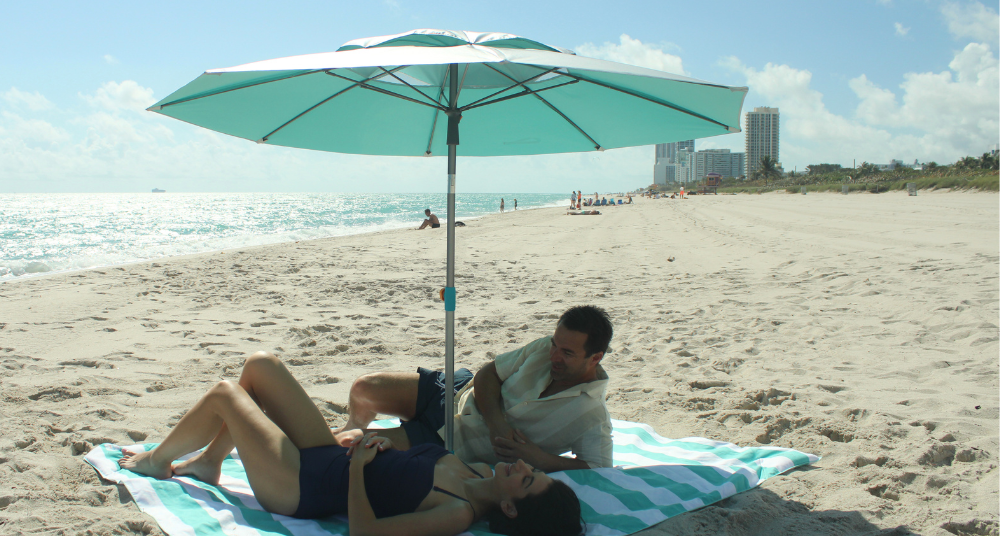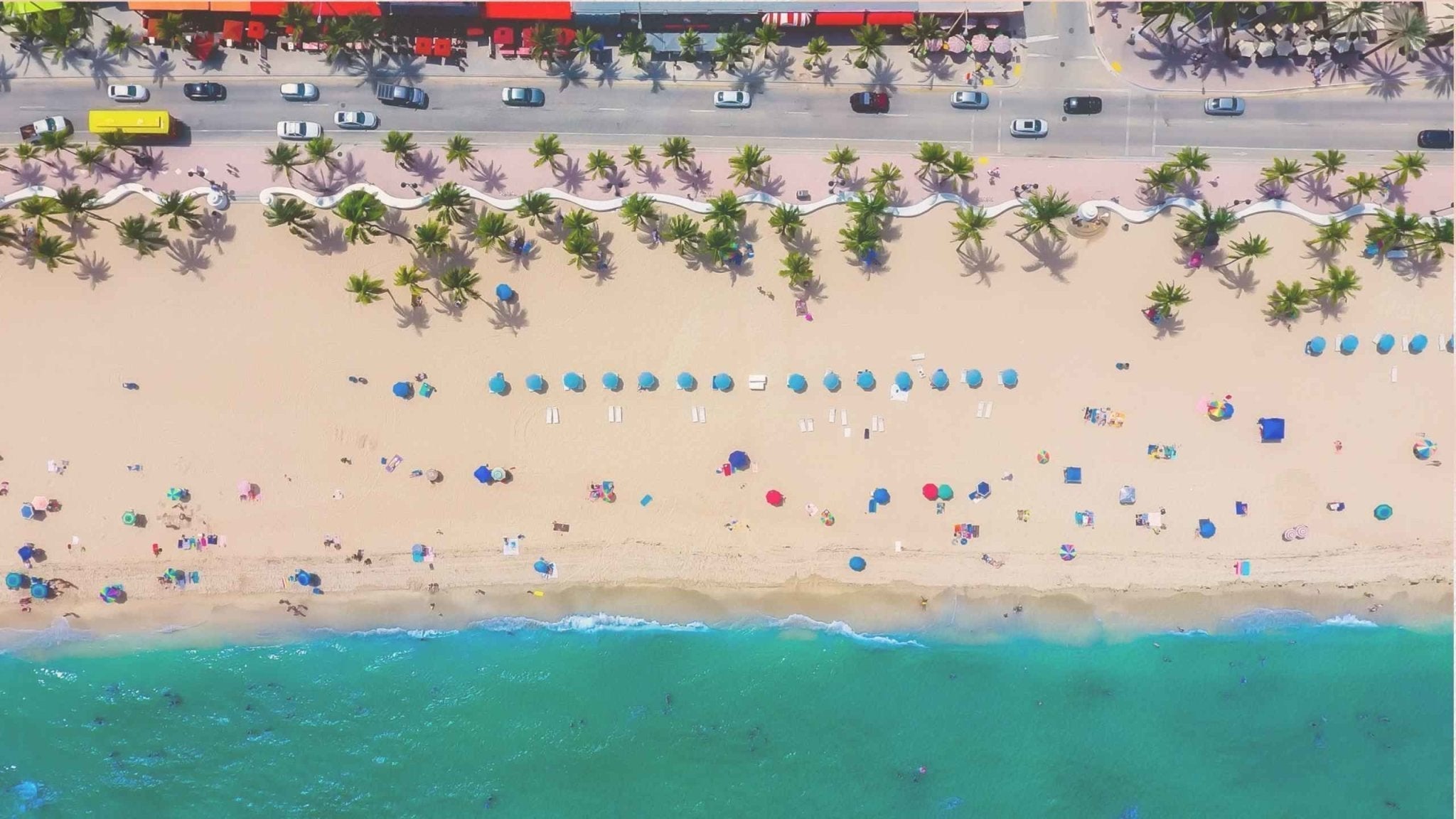Editor's Note: This is a deep dive on UPF fabrics. For our complete guide on the 3-part sun safety system (shade, sunscreen, and gear), check out our new pillar page: The Ultimate Guide to Sun Safety.
By Agnes, Co-Founder of Handy Beach Goods
As a mom of two sun-sensitive kids, I used to think any umbrella meant we were safe. If it cast a shadow, we were covered—right? Not exactly. Many umbrellas use thin fabric that lets UV through. Color and UPF rating matter, and so do stability and venting. If shade can’t hold steady, or the fabric is too sheer, you’re not getting the protection you think you are.
That’s why we built the Handy Beach Umbrella & Anchor System—to give families real shade, real protection, and a setup that actually stays put.
30-second takeaway: Dense 160 gsm fabric means a tighter weave, letting less UV through. A UPF 55+ reflective (silver) outer canopy bounces UV + heat. A vented canopy + stable hammer-in anchor keep that shade where you set it. Our system sets up fast in ~10 seconds, so you actually secure it right every time.
1. Why Thicker Fabric Matters for Real UV Protection
Our umbrella uses 160gsm RPET fabric, which is over 33% thicker than standard umbrellas. That might sound technical, but here’s why it matters:
- Thicker fabric = tighter weave = fewer UV rays getting through.
- It’s more durable, so it won’t wear down or thin out over time.
- It offers better real shade—the kind that actually cools you down.
- This level of thickness is usually found in high-end commercial umbrellas—but we made it easy to carry, because we’re parents, not hotel staff.
Tighter weave + higher mass fabric is the foundation of a UV-blocking beach umbrella. It reduces transmission before coatings or linings do their work.
What we do: 160gsm RPET canopy fabric with a tight weave for lower UV transmission and better real-world shade.
2. Why the Silver Lining Isn’t Just Pretty—It’s Powerful
Most umbrellas rely on fabric color alone to block light. Lighter shades (yellow, light blue, white) can let more UV through; darker colors block more but trap heat and turn your shade into a mini sauna. A reflective (silver) outer canopy bounces UV and infrared heat away before they warm the fabric, so shade feels cooler and protection is more consistent. It can feel up to ~10°F cooler underneath (conditions vary by sun, wind, and time of day).
What we do: A UPF 55+ reflective (silver) outer canopy that helps block more UV and shed heat—real relief on bright, hot beach days.
3. UPF 55+: What It Means, and Why It’s a Big Deal
UPF is to fabric what SPF is to sunscreen—it tells you how much UV passes through the fabric swatch in lab tests. UPF 50 means no more than 1/50th (≈2%) of UV gets through under standardized test conditions; UPF 55+ pushes transmission even lower, adding meaningful protection over a long beach day.
But real life isn’t a lab. Two umbrellas that both “say UPF 50” can perform differently on the beach because protection drops when fabric gets wet, stretched, or worn. Design also matters: if shade shifts with the wind, your skin gets inconsistent coverage even if the fabric itself tested well.
What we do: We start with dense 160 gsm, tightly woven RPET and a UPF 55+ silver-lined canopy, then pair it with a vented, anchored design so the protection you paid for actually stays where you set it. Sunscreen, hats, and sunglasses still recommended.
UV-Ready Checklist (Screenshot This)
- ✅ Dense, tight-weave canopy (high gsm)
- ✅ UPF 50+ minimum; UPF 55+ preferred
- ✅ Silver-lined canopy to reflect UV and heat
- ✅ Vented canopy so wind pressure escapes (less billowing = steadier shade)
- ✅ Stable anchoring so shade stays where you set it
- ✅ Durable, planet-kind materials built for seasons, not weeks
Read More About Sun Protection
- Why fabric weave and color matter (Skin Cancer Foundation)
- Why shade alone isn't foolproof (JAMA Dermatology Study)
4. Why Wind-Powered Shade Isn’t Consistent Shade
You’ve probably seen the sail-style shades that float on a breeze. They feel airy on steady-wind days. The catch: the shade moves with the wind—one minute you’re covered, the next a shoulder or back is exposed. When the breeze drops or shifts, UV coverage becomes patchy, and reflected light from sand and water still reaches skin even in shade. For naps, snacks, and all-day hangs, a vented, anchored umbrella keeps protection where you set it.
What we do: Our hammer-in anchor sets in about 10 seconds, and the vented canopy lets gusts escape so the shade—and the protection—stay put. Compare options in our 2025 wind comparison (Handy vs others).
5. Durable, Planet-Kind, and Made for Real Beach Life
Wind and salt are tough on flimsy umbrellas. Choosing durable fabric and solid hardware isn’t just nicer—it protects better and lasts longer. Our canopy fabric is crafted from recycled bottles (about ~80 per canopy) to reduce demand for virgin polyester, so you get long-lasting protection without adding to the plastic problem we all see on the coast.
- Durable 160 gsm canopy that resists fading and wear
- Metal anchor design resists flex and fatigue
- Reinforced canopy and robust hardware for seasons, not weeks
- Planet-kind materials made from recycled plastic bottles
What we do: A thick RPET canopy + durable steel anchor, designed to be used and repaired—not replaced. Planet-kind and protection-forward can be the same thing. Explore the details on our sustainability page.
Final Takeaway
We built this because our family needed shade that really protects. Handy combines tight-weave 160-gsm fabric and a UPF 55+ reflective (silver) outer layer for cooler, consistent coverage. Venting manages gusts; the hammer-in anchor locks in fast (about 10 seconds)—so you can relax, not chase your shade.
See the Handy Beach Umbrella & Anchor System
Frequently Asked Questions (FAQs)
Do all beach umbrellas block UV?
No. Many thin or sheer fabrics let significant UV radiation through, even if they cast a shadow. Look for a dense, UPF-rated canopy (UPF 50+ minimum) and a reflective (silver) lining to reflect UV and heat.
What UPF rating should I look for in a beach umbrella?
UPF 50+ is the standard for "Excellent" protection, blocking at least 98% of UV rays. We recommend UPF 55+ for even greater protection over a long beach day.
What color umbrella blocks the most UV?
Darker colors (like black or navy) generally absorb more UV rays than light colors. However, a silver-lined canopy is even better, as it reflects UV and heat, keeping the shade cooler.
Do I still need sunscreen under an umbrella?
Yes, absolutely. Umbrellas reduce direct UV but cannot block all reflected and scattered UV rays from the sand and water. The EPA and Skin Cancer Foundation recommend a combination of shade, sunscreen, and protective clothing.
Are wind-powered beach shades good for UV protection?
They can be, but the shade is often inconsistent. Because they rely on wind, the shade can move, shift, or disappear when the breeze drops, leading to patchy UV coverage. An anchored, vented canopy keeps protection where you set it.
About the Author
Written by Agnes, co-founder of Handy Beach Goods and a Florida mom of two. After one too many sunburns under flimsy shade, she set out to design a UPF-forward umbrella that keeps protection steady on real beach days.
A Final Disclaimer on Sun Safety
No shade system offers 100% protection. Use broad-spectrum sunscreen, protective clothing, hats, and sunglasses, and follow beach UV guidance for your area. Always set up and secure your umbrella per the manufacturer’s instructions; lower or close it in strong or shifting winds.



